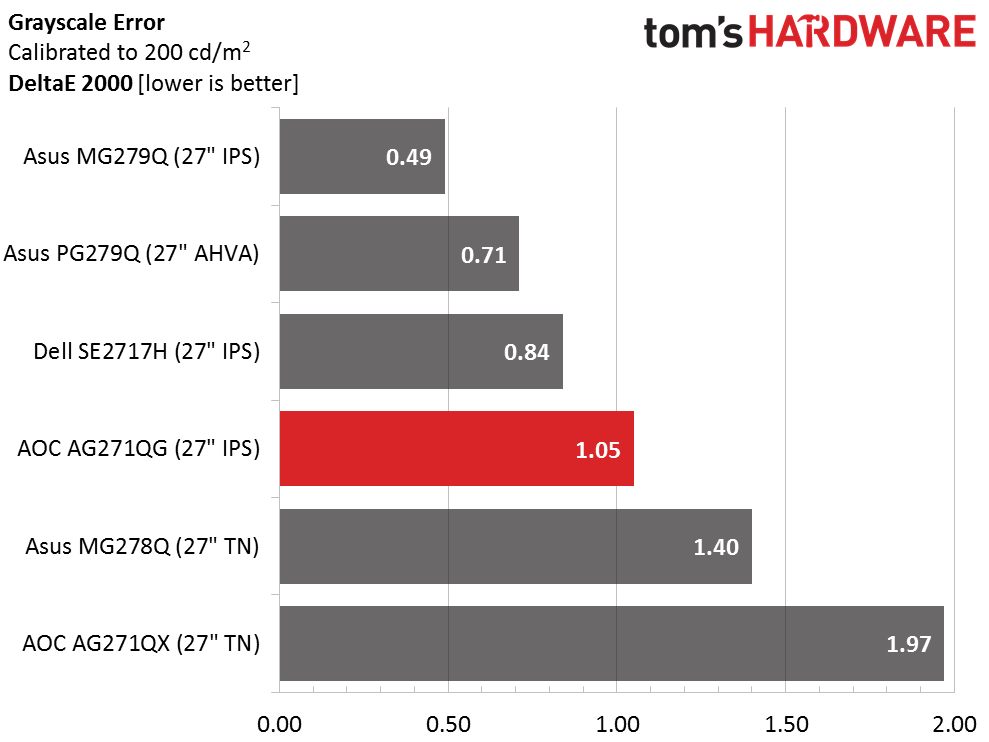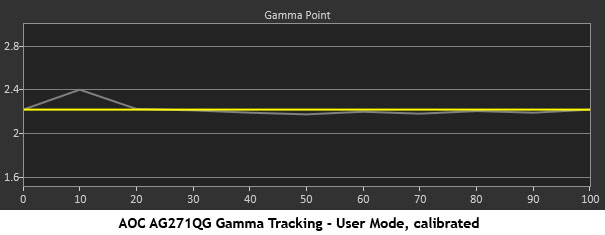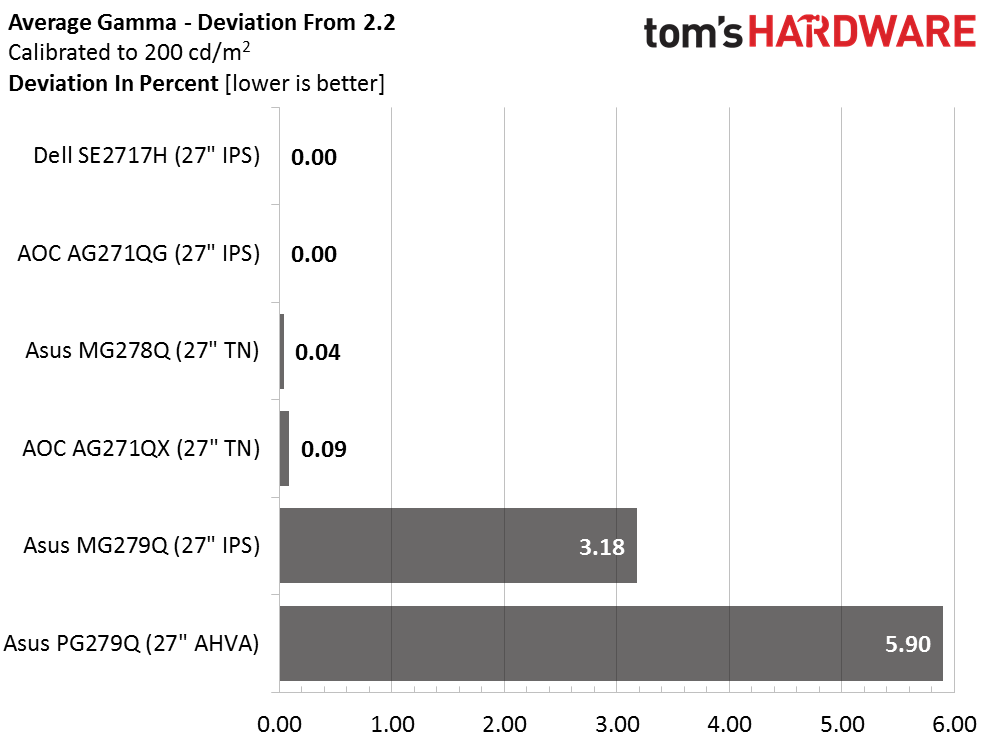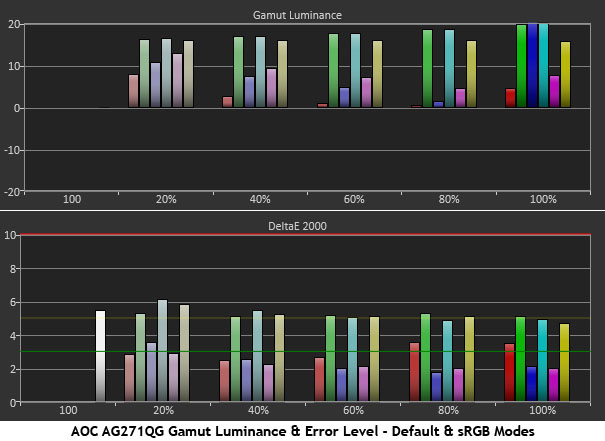AOC AG271QG Agon 27-inch G-Sync Monitor Review
Why you can trust Tom's Hardware
Grayscale, Gamma & Color
Grayscale Tracking
Our grayscale and gamma tests are described in detail here.



The AG271QG only offers white balance presets; there are no traditional picture modes. In addition to warm, normal, and cool there are sRGB and User options. Warm is the default and looks a tad green both in our tests and to the eye. Changing to sRGB doesn’t affect the grayscale, or anything else for that matter. All other adjustments, brightness and contrast included, are locked out.
The User mode starts at pretty much the same place as warm and sRGB except it is a little greener. At least now we have RGB sliders to work with. They start at center range, but we found clipping when we moved them above 50, the default value. Maintaining proper color saturation tracking and gamma requires you only lower the settings. Fortunately only small tweaks are necessary to bring the average error level down below the visible threshold.
Comparisons


4.04dE average is a little high for a modern gaming monitor and it places the AG271QG fifth in our group. Remember that 3dE is our benchmark for out-of-box performance. At these prices, we expect to see better numbers before calibration. Making the appropriate adjustments takes the result down to a respectable 1.05dE. Though the three screens on top post impressive measurements, the visual difference between any of the six displays is minute. It should be noted that a gamma adjustment is necessary to achieve this. We’ll detail that for you now.
Gamma Response



The default gamma trace shows significant clipping at the top of the brightness scale. Not only is highlight detail affected, color saturation in the mid-tones is too. We’ve demonstrated on many other monitors the importance of accurate gamma tracking and how it relates to color accuracy throughout the gamut space.
Selecting the user mode removes the clipping issue but leaves the trace a bit on the dark side. This maintains good contrast but the picture still looks a little dull. Changing the preset from Gamma 1 to Gamma 2 nails the 2.2 line at every level except 10% which is still slightly dark. It’s an invisible error that has no visible effect on actual content. The only downside is that both sequential and ANSI contrast are reduced a bit. We think that’s a reasonable trade off for the gains in color accuracy, which you’ll see in the next section.
Comparisons


The AG271QG stacks up well to the competition in gamma performance. An average value of 2.2 means there is no deviation from our standard, and its tight .23 range of values would be even better if not for the slight aberration at 10%. You’ll see how this excellent result impacts color now.
Get Tom's Hardware's best news and in-depth reviews, straight to your inbox.
Color Gamut & Luminance
For details on our color gamut testing and volume calculations, please click here.






Looking at just the outer color points, you can see the AG271QG has an accurate native gamut. But when you look inside the triangle, and at the luminance bars, a different story emerges. The clipping we measured in the gamma test translates to mid-tone errors in all colors. That means most content, which is concentrated in that area, won’t look its best.
Switching to the User mode with no further adjustments is a start, but there is still room for improvement. One could simply select Gamma 2 and get 95% of the performance we measured. But if you calibrate yourself, or try our settings, you can unlock the QG’s full potential. Our final chart shows saturation points that are all on target and luminance levels that are almost perfectly neutral. The final DeltaE numbers are impressive.
Comparisons


The AG271QG takes a win in the gamut accuracy test with its on target saturations and almost perfect luminance levels. This kind of color happens more often in professional displays rather than gaming monitors. Our only lament is the loss of contrast. But as we’ve already said, it’s worth losing a bit of dynamic range to experience color this good.
Those requiring maximum gamut volume will find that the AOC provides a little bonus red and renders 104.98% of the sRGB space. While this is fine for gaming and general use, color critical tasks may require an ICC profile for maximum precision.
Current page: Grayscale, Gamma & Color
Prev Page Brightness & Contrast Next Page Viewing Angles, Uniformity, Response & Lag
Christian Eberle is a Contributing Editor for Tom's Hardware US. He's a veteran reviewer of A/V equipment, specializing in monitors. Christian began his obsession with tech when he built his first PC in 1991, a 286 running DOS 3.0 at a blazing 12MHz. In 2006, he undertook training from the Imaging Science Foundation in video calibration and testing and thus started a passion for precise imaging that persists to this day. He is also a professional musician with a degree from the New England Conservatory as a classical bassoonist which he used to good effect as a performer with the West Point Army Band from 1987 to 2013. He enjoys watching movies and listening to high-end audio in his custom-built home theater and can be seen riding trails near his home on a race-ready ICE VTX recumbent trike. Christian enjoys the endless summer in Florida where he lives with his wife and Chihuahua and plays with orchestras around the state.
-
dstarr3 I appreciate the slightly more grown-up look to this. All the Acer and ASUS gaming monitors look dressed up for 12-year-olds and I'm not going to pay nearly $1k for the privilege of putting those horribly gaudy things on my desk. So this is an improvement. I think I'd still rather have the Dell S2716DG, though. Or at least something that looks like it.Reply -
beshonk How come we haven't seen a review or mention of the viewsonic xg2703? I have that monitor and it is perfect. The price is right and the stand doesn't look gamey like the Acer and Asus.Reply -
Bradley Coates I would also like to see a review of the Viewsonic XG2703. It uses the same panel as this AOC does, but has better on-screen menu.Reply -
ubercake Just curious... Why does the PG279Q contrast ratio look so different in this review compared to its own review?:Reply
http://www.tomshardware.com/reviews/asus-pg279q-rog-swift-27-inch-165hz-monitor,4428-4.html
ANSI versus other method of contrast measurement? -
WyomingKnott What's the thing on the back that looks like an antenna sticking out? Black, about halfway up the right side (left side in the back view)?Reply